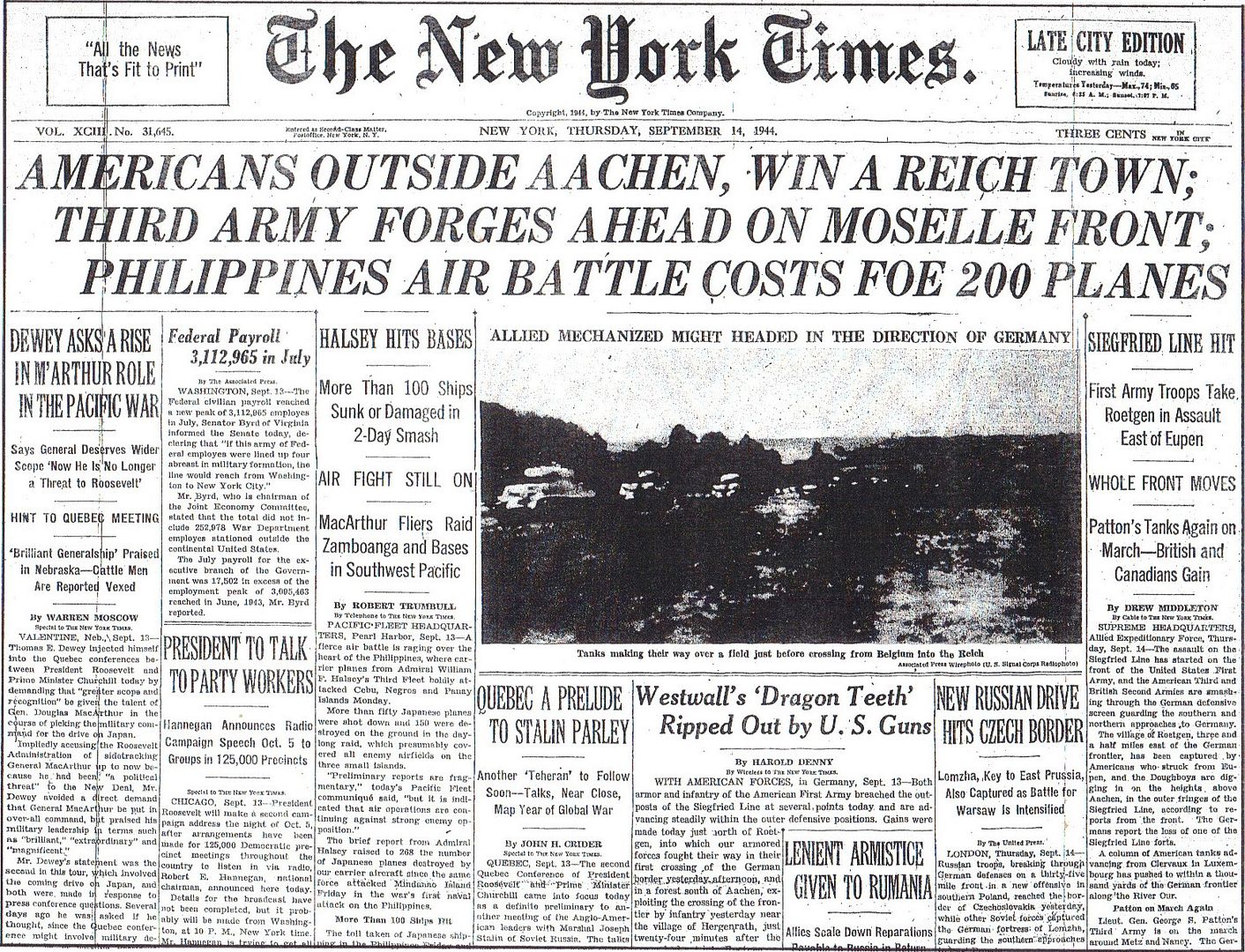
Posted on 09/14/2014 4:23:20 AM PDT by Homer_J_Simpson

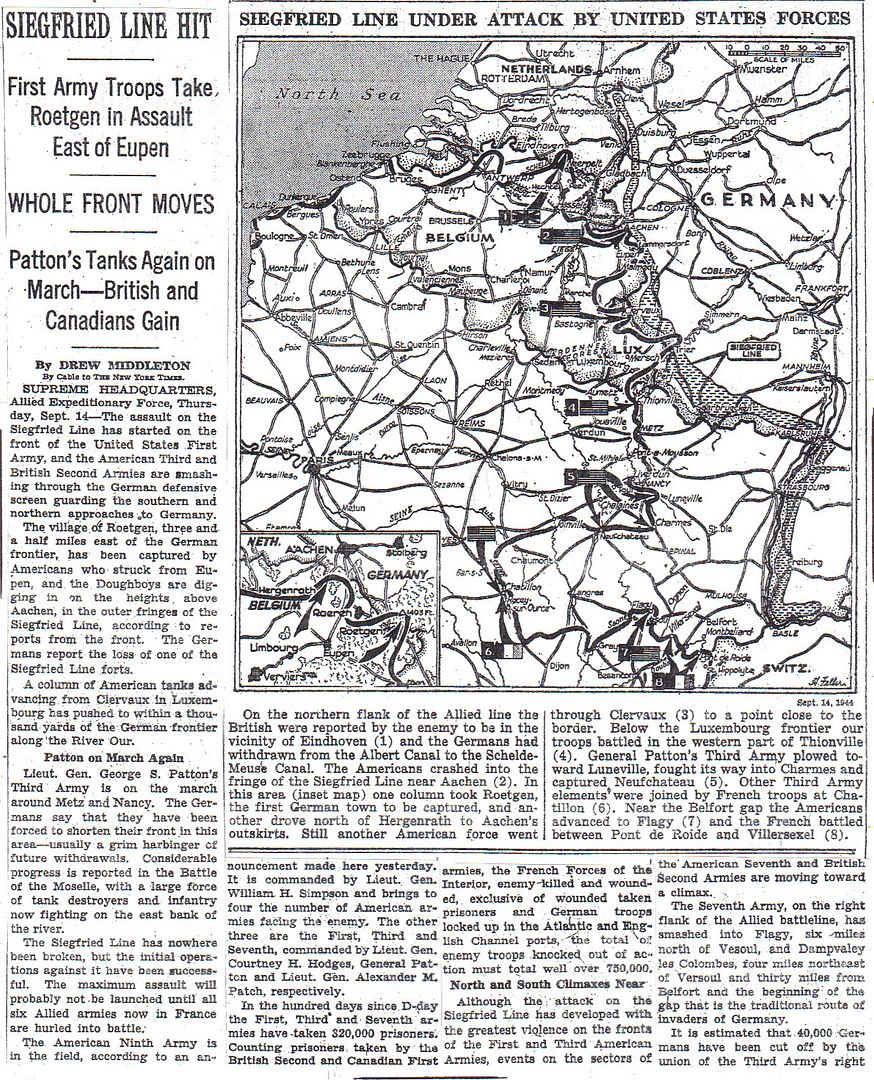
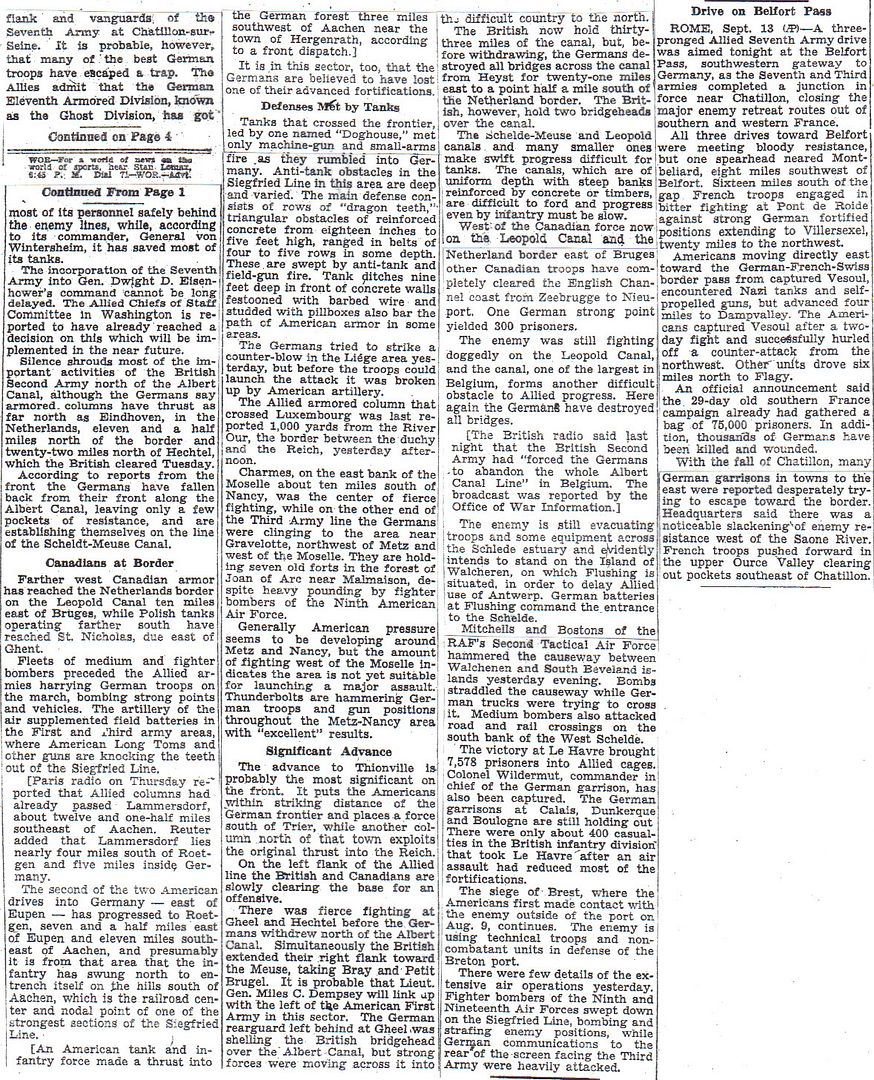
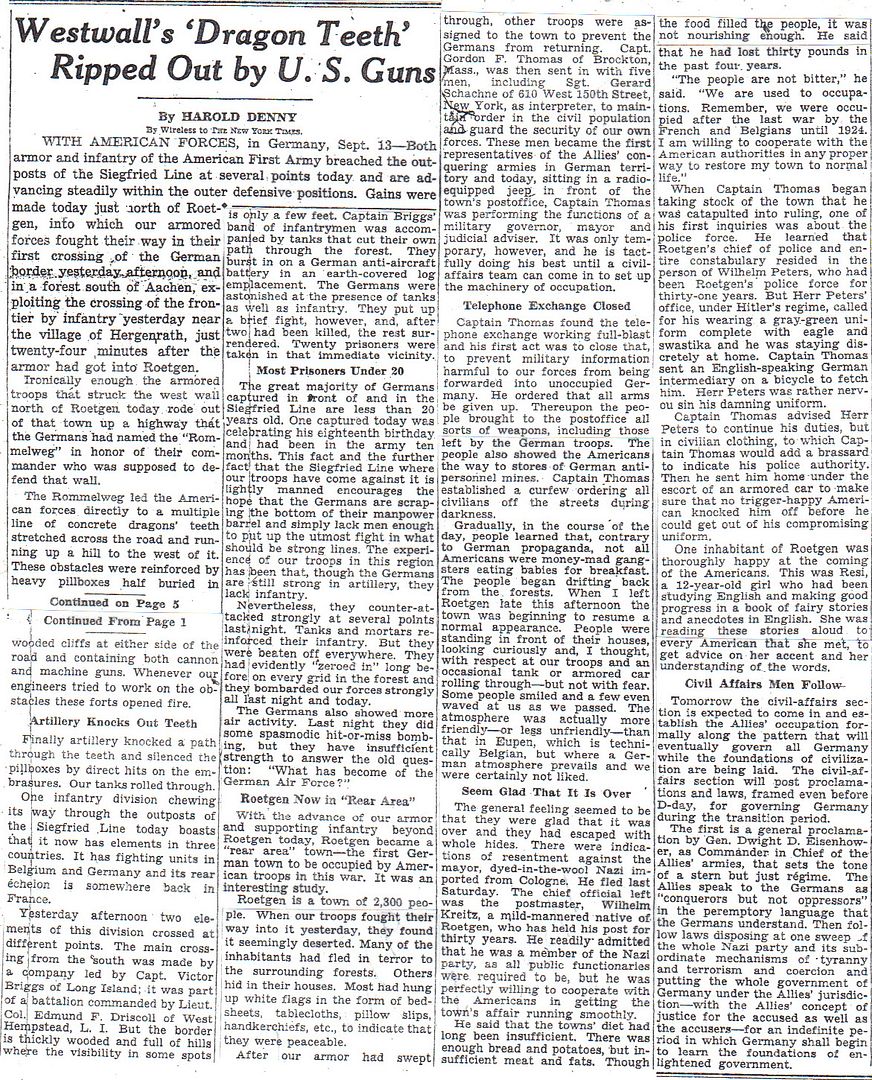
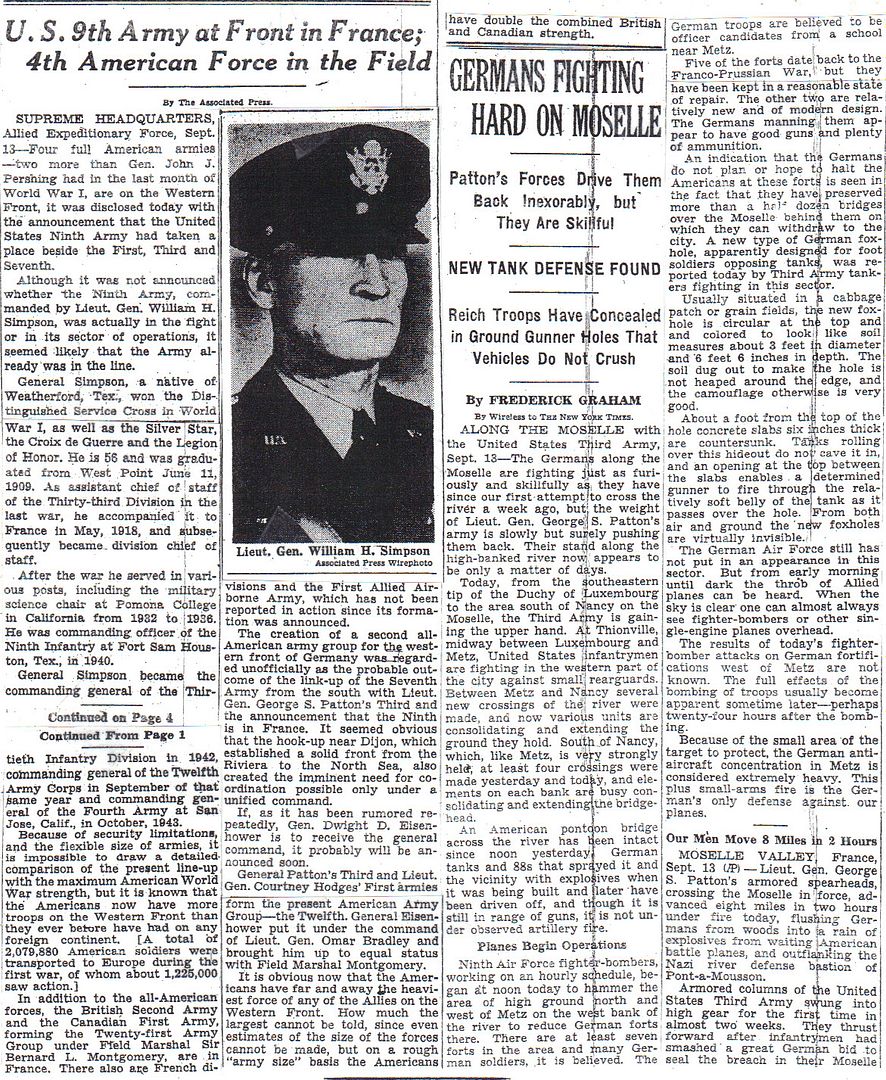
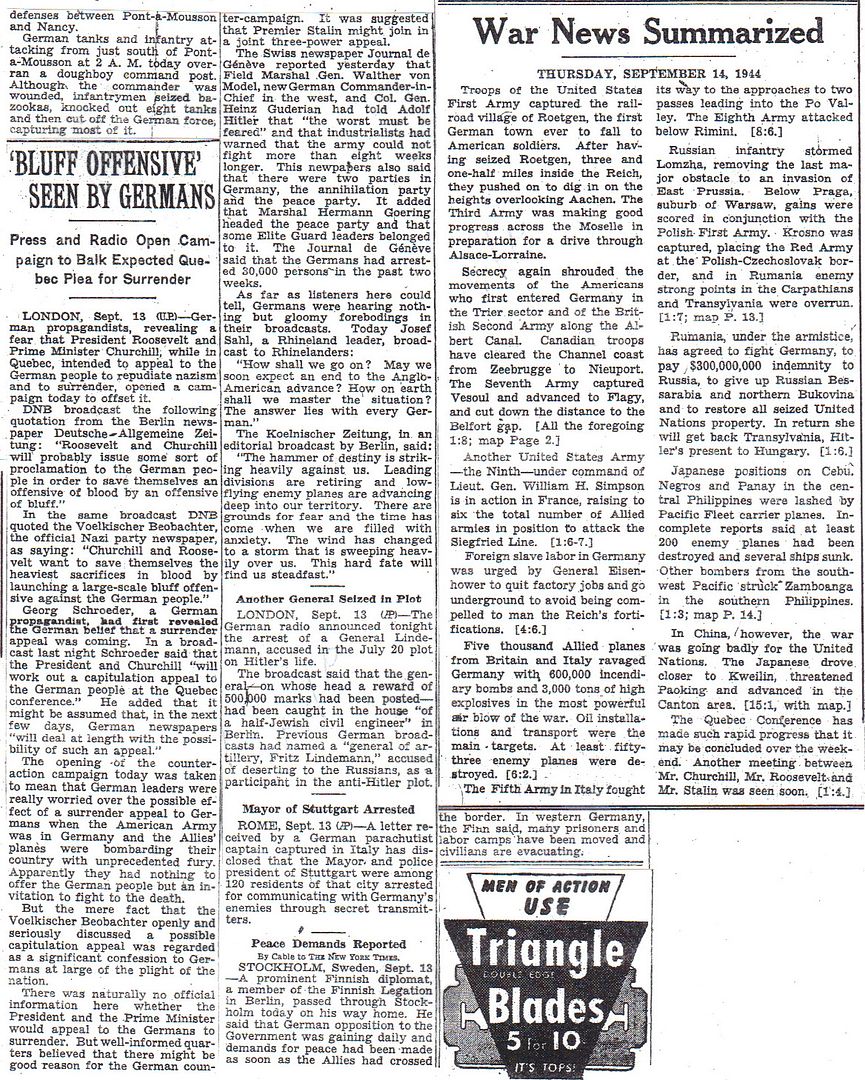
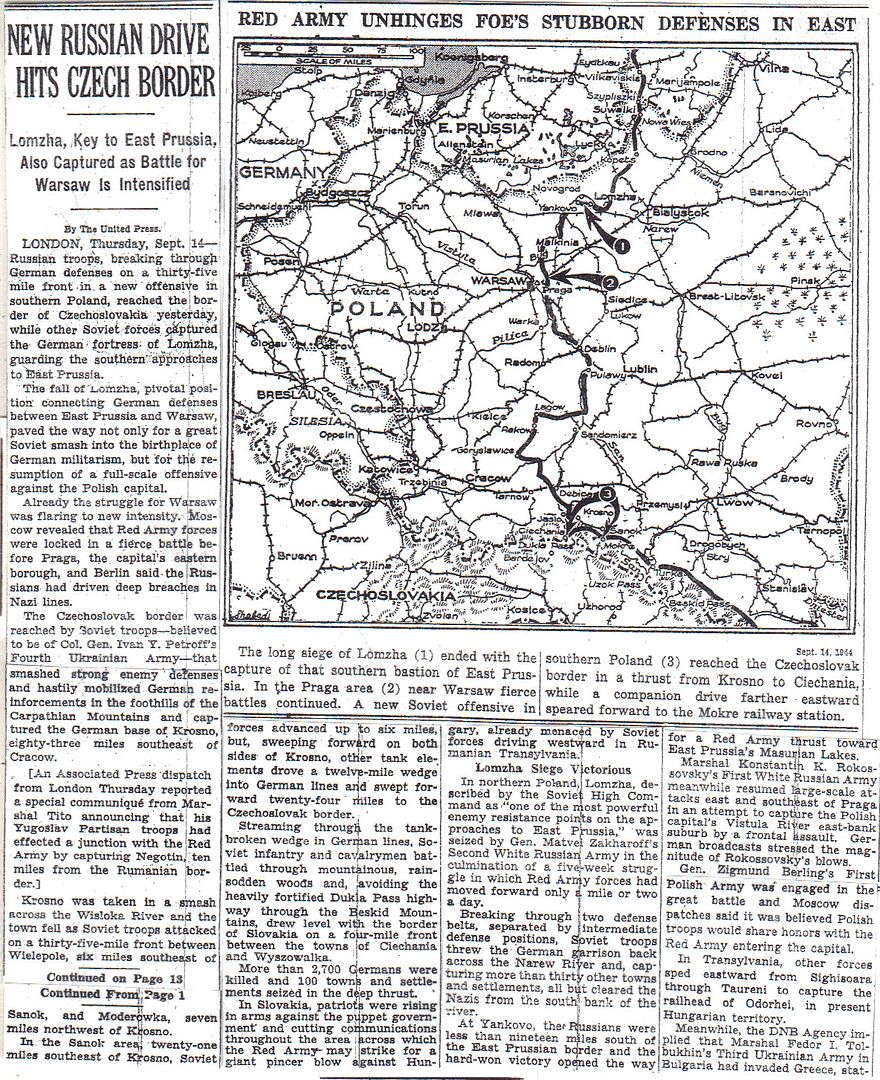
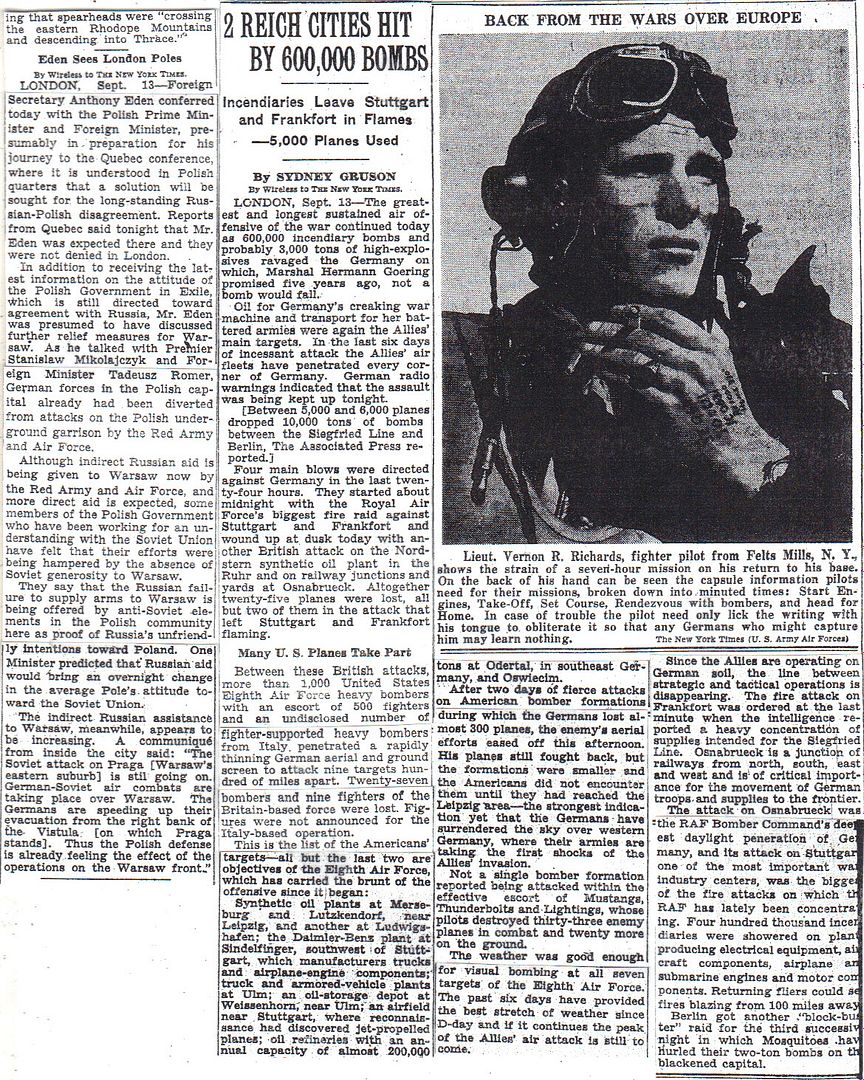
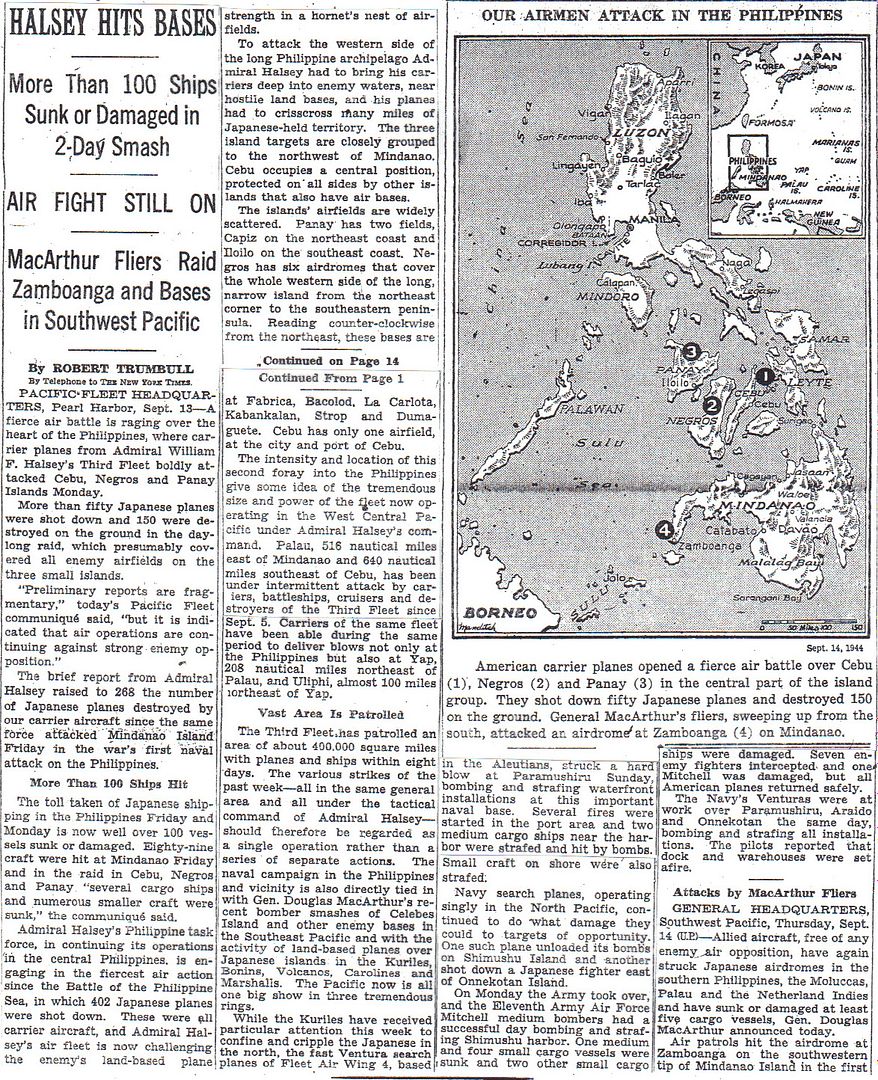
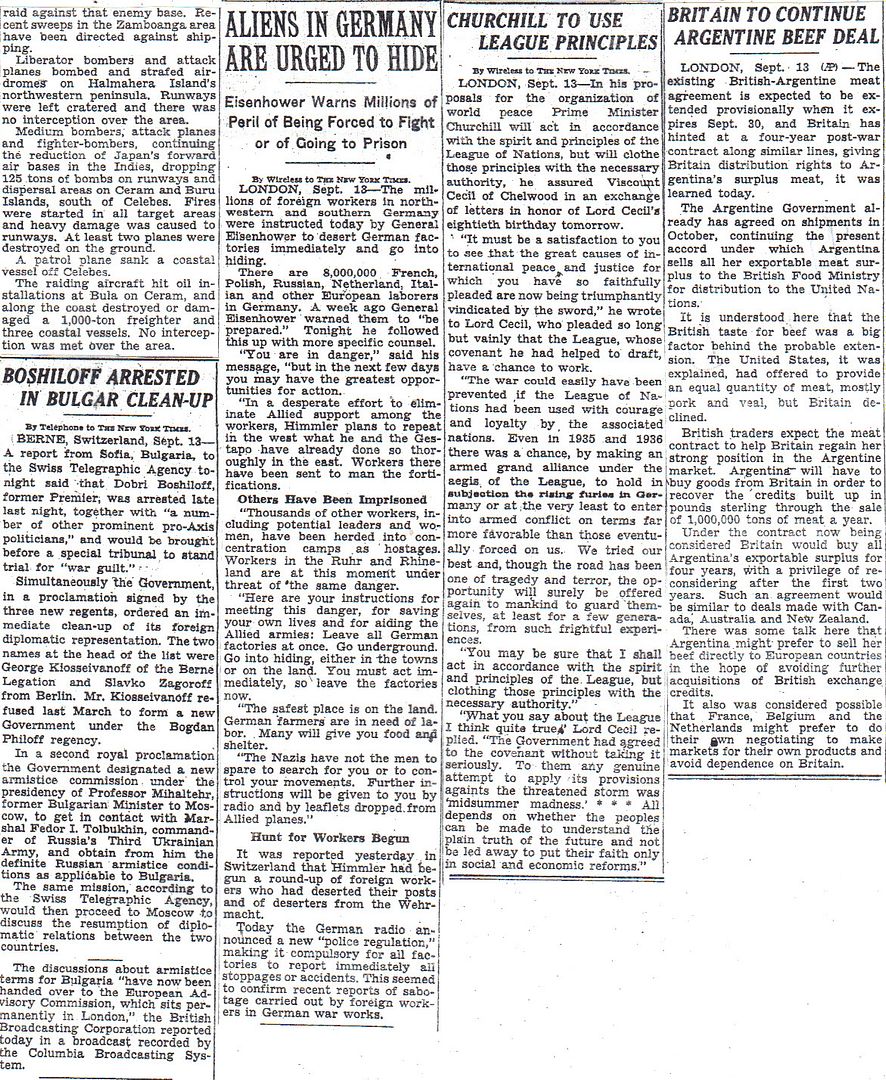
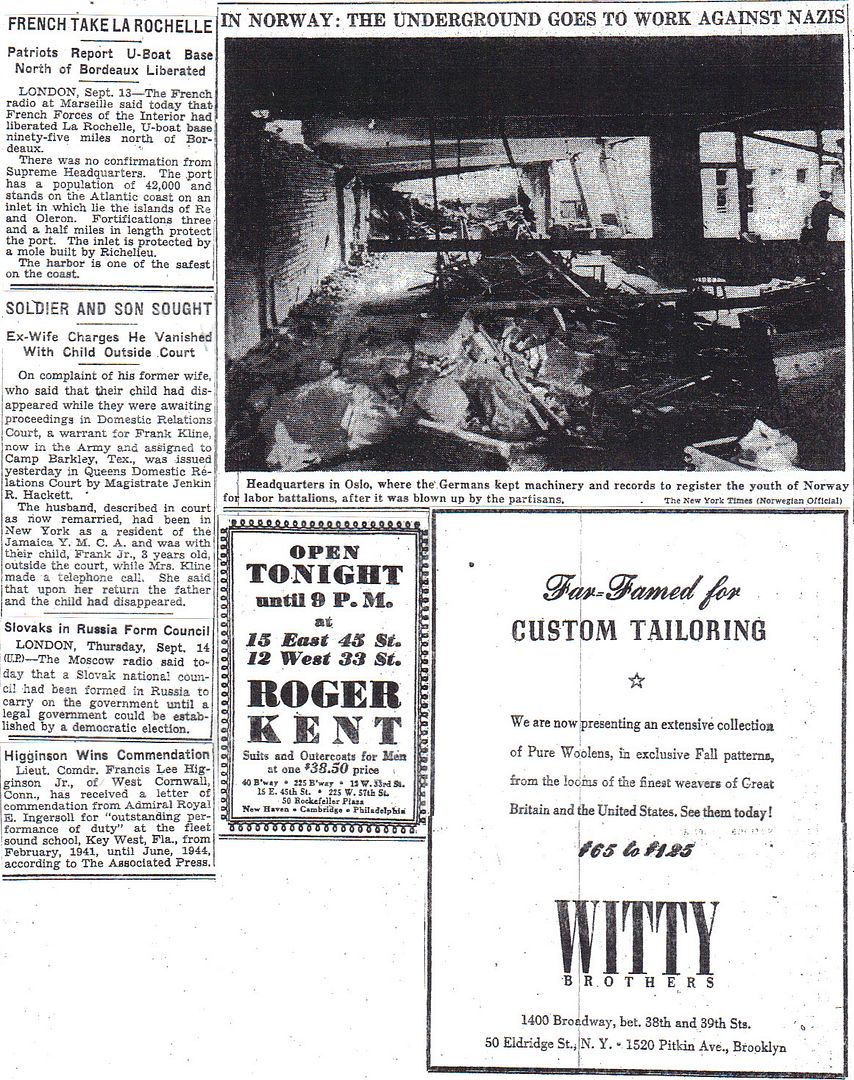

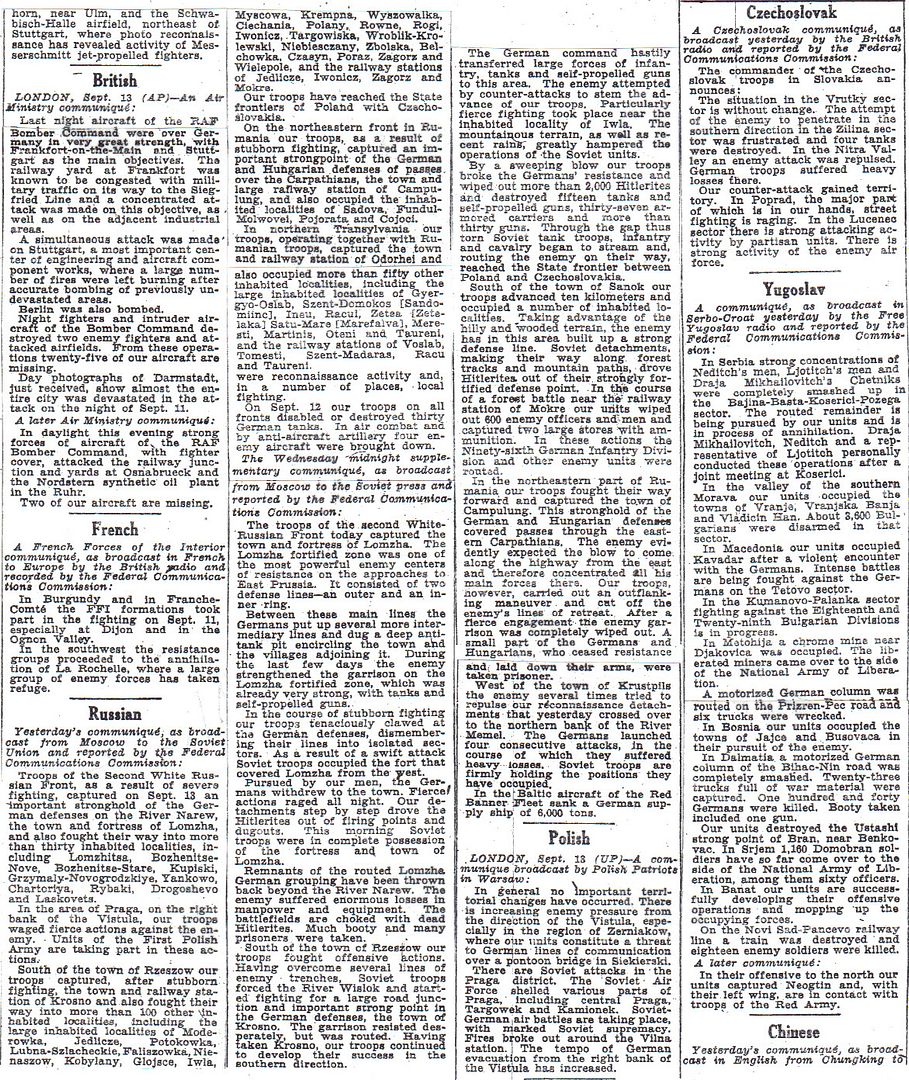

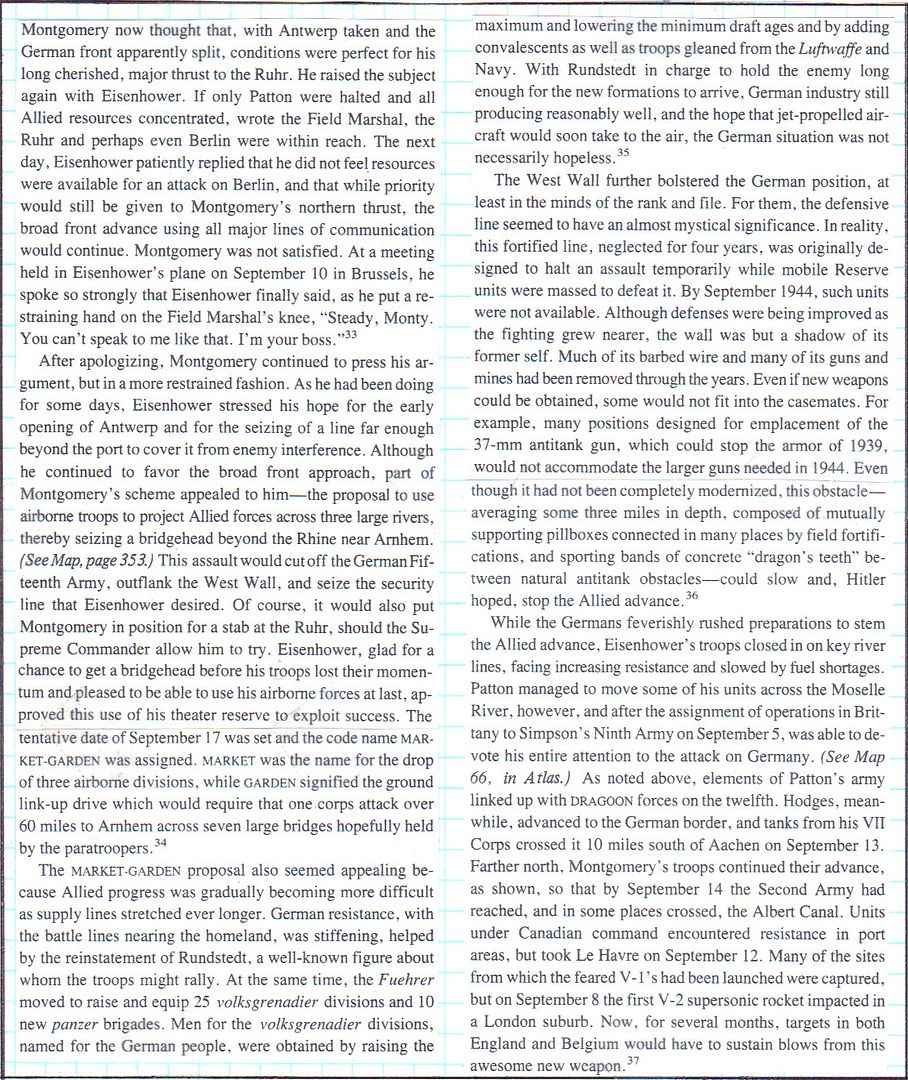
The West Point Military History Series, Thomas E. Griess, Editor, The Second World War: Europe and the Mediterranean
Pray see this. * Although this matter is being settled at home it would be best that the Chiefs of Staff themselves should express a view.
2. I have drafted the following for Mr. Lyttelton, on which I should also like their opinion:
“I am very doubtful myself whether the German war will end by the end of the year. It may struggle over in a reduced condition into 1945. Nevertheless I approve the practical steps you propose to take, subject to Cabinet and Defence Committee agreement. You may therefore submit your paper to the Cabinet as you wish.”
* Telegram from the Minister of Production about the effect on production of the Cabinet decision that for man-power purposes it could now be assumed that the war against Germany would not continue beyond the end of 1944.
Winston S. Churchill, Triumph and Tragedy
* The “thousand yard stare” doesn’t just emanate from infantrymen.
http://www.onwar.com/chrono/1944/sep44/14sep44.htm#
Soviets secure Warsaw suburb
Thursday, September 14, 1944 www.onwar.com
The poster reads: Drive out the Geman Invader. The Red Army is now in the surburbs of Warsaw, Poland [photo at link]
On the Eastern Front... Soviet troops of 1st Belorussian Front capture the Warsaw suburb of Praga.
In Italy... Forces of British 8th Army capture Zollara and have thereby clear the Gemmano Ridge of German resistance. Lead elements advance to the Marano River.
In the Philippines... Three groups of US Task Force 38, with 12 carriers, conduct air strikes on Japanese positions on the Visayas or central Philippine islands.
In the Palau Islands... US naval forces, commanded by Admiral Oldendorf, continue to bombard Peleliu and Angaur islands as well as conducting minesweeping operations offshore.
In Canada... The Octagon Conference continues. Churchill and Roosevelt and their staffs meet in Quebec to discuss strategy.
http://www.etherit.co.uk/month/thismonth/14.htm
September 14th, 1944 (THURSDAY)
UNITED KINGDOM:
STRATEGIC OPERATIONS: The US Eighth Air Force in England flies Mission 632: 2 B-17 control aircraft and 2 B-17 CASTOR drones fly an APHRODITE mission to the oil refinery at Hemmingstedt, Germany; the target is missed.
TACTICAL OPERATIONS: C-47s of the First Allied Airborne Army’s US IX Troop Carrier Command continue large-scale supply and evacuation missions in France.
Minesweeper HMS Serene commissioned. Destroyer HMS Barfleur commissioned. Minesweeper HMS Chameleon commissioned.
NETHERLANDS: The U.S. 30th Infantry Division reaches the Maas River and crosses the canal to Maastricht Island late in the day and finds the town undefended.
During the day, 35 Lancasters and ten Mosquitos of RAF Bomber Command bombed “an ammunition dump” (possibly a suspected V-2 store) near The Hague at Wassenar. The bombing is considered to be accurate until smoke and dust covered the target.
FRANCE: British Field Marshal Bernard Montgomery, Commander-in-Chief 21st Army Group, issues orders for the next phase of the offensive to begin on 17 September, calling for the British Second Army to secure crossing of the Rhine and Meuse Rivers in preparation for a major drive on the Ruhr and for the Canadian First Army to open the port of Antwerp and seize Boulogne and Calais. Offensive operations are virtually at a standstill while supplies are being brought forward and units regrouped.
In northern France, the U.S. XII Corps completes the envelopment of Nancy. The French 2d Armoured Division makes contact with a patrol of the French 1st Armoured Division that advanced up from southern France.
In northern France, the USAAF Ninth Air Force activates HQ XXIX Tactical Air Command (Provisional) at Vermand, in anticipation of operating with the U.S. Ninth Army, shortly to join the Twelfth Army Group; Brigadier General Richard E Nugent is Commanding General; about 140 B-26 Marauders and A-20 Havocs bomb gun emplacements and strongpoints in the Brest area. C-47 Skytrains of the First Allied Airborne Army’s IX Troop Carrier Command continue large-scale supply and evacuation missions in France.
In southern France, bad weather limits USAAF Twelfth Air Force fighters to a few sweeps but 53 USAAF Fifteenth Air Force B-24 Liberators fly supples from Italy to France.
GERMANY: The U.S. 3d Armored Division thrusts to the Vicht River southwest of Stolberg and crosses and elements also reach a suburb of Aachen. The U.S. 4th Infantry Division penetrates the West Wall in the Schnee Eifel while the 28th Infantry Division begins major attacks in an effort to breach the Wall in its sector. The 5th Armored Division begins to cross the Sauer River into Germany at Wallendorf.
During the day, RAF Bomber Command dispatched 184 aircraft, 133 Halifaxes and 51 Lancasters, to Wilhelmshaven but recalled while still over the North Sea; no reason for this is given in Bomber Command records. All aircraft returned safely.
U-2513 and U-3008 launched.
U-2346 laid down.
NORWAY: Bergen: One of Britain’s most successful secret weapons - a midget submarine able to penetrate the best defended waterways - has struck again. This time the target was a big floating dock, blown up in Bergen harbour. Lt. H. P. Westmacott skippered the four-man craft, X24, as it slipped through 30 miles of islands offshore and a minefield and into a fjord to sail at periscope depth to the harbour. After diving to 35 feet to avoid collision with a merchant ship, Westmacott attached delayed-action charges to the target and escaped. It is the second such raid on Bergen by Westmacott in X24.
POLAND: Units of the Soviet First Belorussian Front assisted by Polish forces enter the Warsaw suburb of Praga. But the Germans are preparing for a stand along the line of the Narew and Vistula Rivers.
FINLAND: By this date all German troops have left Southern Finland.
U.S.S.R.: The Finnish peace delegation has waited for a week at Moscow for the negotiations to begin. Delay is caused by disagreements between the Soviets and British over the terms of the interim Peace Treaty (the final treaty will be the one concluded with the Soviet Union, UK and the Dominions at Paris in 1947). Today the two allies finally reach an agreement, and the Fenno-Soviet negotiations are to begin in evening. However, Prime Minister Antti Hackzell, who is the chairman of the Finnish delegation, suffers brain haemorrhage just hours before the first session is to start and is paralysed. Minister of Defence Gen. Rudolf Walden acts as the head of the delegation in the first session. Minister of Foreign Affairs Carl Enckell arrives two days later to replace Hackzell.
The Soviets attack Army Group North with 130 Divisions. General Schorner asks Hitler to let Estonia to go. This time Hitler allows a retreat. (Gene Hanson)
YUGOSLAVIA: A British detachment with 25-pounders (87.6 mm) lands on Peljesac Peninsula and shells Trpanj, the German withdrawal point.
GREECE: During the night of 14/15 September, RAF Liberators of No. 205 (Heavy Bomber) Group attack three airfields in the Athens area: 34 hit Kalamaki Airfield, 31 bomb Eleusis Airfield and 20 bomb Tatoi Airfield.
ITALY: The Canadian First Division of the British 8th Army continues its advance, crossing the Marano River, after capturing the Gemmano Ridge.
The U.S. II Corps continues to hammer the Gothic Line defenses of Il Giogo Pass but is unable to break through. The Canadian 1st Division reaches the Marano River and begins crossing it after capturing the Gemmano Ridge.
US Twelfth Air Force medium bombers attack defensive positions in the east and central parts of the Gothic Line as the enemy fiercely resists, especially at Il Giogo Pass and on Monte Altuzzo; fighter-bombers continue strikes against communications and movement in the Po Valley.
The sailing yacht EROS is torpedoed and sunk by US PT boats off Genoa. She is ex-mercantile, originally built as a yacht for the Rothschild family. 1,019 tons built 1926 in England with some guns. She was seized by the Germans at Toulon in 1942 and redesignated Kriegsmarine Uj.2216 in 1943. [prior information courtesy of Henri Le Masson’s The French Navy, Volume 2, Macdonald and Co., 1969] (Greg Kelley)
BURMA: Japanese troops withdraw from the Manipur river line.
On the Salween front, the Chinese complete the capture of Teng-chung which was entered on 4 August. Since Teng-chung is lost and the Chinese are vigorously resisting in Lung-ling, the Japanese decide to halt their counteroffensive on the Salween front.
JAPAN: During the night of 13/14 September, 3 US Eleventh Air Force B-24s strike Kurabu Cape shipping and airfield on Paramushiru Island in the Kurile Islands.
MARCUS ISLAND: USAAF Seventh Air Force B-24 Liberators on armed reconnaissance bomb Marcus Island. The island is located in the North Pacific about 768 nautical miles (1 422 kilometers) west-northwest of Wake Island and is used as a refueling point for Japanese aircraft en route to the Central Pacific.
CAROLINE ISLANDS: USAAF Seventh Air Force B-24 Liberators from Eniwetok Atoll, Marshall Islands, bomb Truk Atoll and Gilbert Islands-based B-25 Mitchells hit Ponape Island.
VOLCANO ISLANDS: USAAF Seventh Air Force B-24 Liberators from Saipan Island, Mariana Islands, bomb Iwo Jima Island.
SOUTH CHINA SEA: The USN submarine USS Pargo (SS-264) lays mines near Natuna Island.
SOUTHWEST PACIFIC: USN Task Group 38.2 (TG 38.2, Rear Admiral Gerald F. Bogan) attacks Japanese shipping and installations on and around Panay and Negros Islands, supported by TG 38.3 (Rear Admiral Frederick C. Sherman). TG 38.1 (Vice Admiral John S. McCain), en route to support the Morotai landings, carries out strikes on Japanese installations on Mindanao; during the course of these operations, SB2Cs Helldivers of Bombing Squadron Two (VB 2) sink a fast transport in Davao Gulf. Meanwhile, destroyers USS Farenholt (DD-491), USS McCalla (DD-488), and USS Grayson (DD-435), detached from TG 38.1, bombard suspected Japanese radar installation on Cape San Augustin, at the mouth of Davao Gulf.
NETHERLANDS EAST INDIES: 5620 Dutch, English, Australian and American POWs and Javanese slave labourers are loaded aboard the Japanese cargo ship “Junyo Maru” at Batavia on Java. The ship will be sunk by an RN submarine four days later. (See 18 September)
CANADA: At the OCTAGON Conference being held in Quebec City, Quebec, (1) representatives of Australia and New Zealand join in conference at and (2) the Combined Chiefs of Staff draw up a new directive for British Admiral Lord Louis Mountbatten, Supreme Allied Commander, South East Asia Command, making his primary mission the recapture of Burma as quickly as possible. Operation DRACULA (plan for the capture of Rangoon, Burma in 1944) and that part of Operation CAPITAL (the attack across the Chindwin River to Mandalay, Burma) requiring an air and land route to China be opened and approved with a target date of 15 March 1945.
Frigate HMCS Waskesiu departed departed Londonderry with Convoy ONF-253.
Frigate HMCS Stettler attacked by U-802 Kptlt Helmut Schmoeckel CO. U-802 was a type IXC/40, U-boat, built by Deutsche Schiff und Machinen Bau AG Seebeck Yard Bremen, commissioned 12 Jun 43, in service 23 months, with a record of sinking 1 ship on 14 Sep 44. Stettler together with other frigates were on a routine patrol of Gaspe Passage when they fell within torpedo range of U-802. Assuming a convoy following astern of the sweep, U-802 tried to slip through the screen. Asdic sounds surrounded it as the formation zigzagged around its base course in full view of Schmoeckel’s periscope, “Suddenly a destroyer turns bows on at full speed, making black smoke”. Incorrect though his assumption was, Schmoeckel could only conclude in that split second that HMCS Stettler had gained asdic contact and was commencing her attack. Pressed by the apparently threatening frigate slicing through an “absolutely smooth, leaden sea (at approximately) 20 knots” Schmoeckel hastily fired a T-5 acoustic Gnat at a range of 500 m. An “explosion,” in the words of the Canadian report, “believed to be a torpedo, occurred 40 yards astern of HMCS Stettler in the ship’s wake.” The crew of U-802 heard their torpedo explode, followed by “the sounds of sinking,” and credited themselves with a kill. Lying under protective layers at a depth of 170 m eight minutes after their attack, they listened in safety to the counter-attacks as “destroyers” crossed overhead. U-802 rounded Cap de la Madeleine by late afternoon on 15 Sep, and let itself drift eastward with the prevailing set of the Gaspe stream.
U.S.A.: The Great Atlantic Hurricane of 1944 made its initial landfall as a Category 3 storm at Cape Hatteras, North Carolina, shortly after 0900 hours. The barometric pressure at Cape Hatteras dropped to 947 millibars (27.97 inches of mercury or 94,71 kPa) with the highest winds clocked at 110 mph (177,0 km/h). From this point forward, the storm began to accelerate to the northeast to a speed in excess of 40 mph (64,4 km/h). By 1200 hours, the hurricane passes 75 miles (120,7 km) to the east of Norfolk, Virginia, and hurricane force winds swept over portions of extreme southeast Virginia. Winds peaked at 73 mph (117,5 km/h) in downtown Norfolk with gusts to 90 mph (144,8 km/h). At Cape Henry in Virginia Beach, Virginia, peak 1-minute winds reached 134 mph (215,7 km/h) with momentary gusts to 150 mph (241,4 km/h), the highest ever observed at any site during the hurricane. The lowest barometric pressure reported at Norfolk during the hurricane was 985.7 millibars (29.11 inches of mercury or 98,58 kPa). The high winds were the result of intensive convective activity which occurred in the western semi-circle of the storm. Over 4 inches (10,2 cm) of rain fell in a three and a half hour period from 1000 hours to 1330 hours. Fortunately for the area the hurricane passed at the time of low tide and tides only reached 6.0 feet (1,8 meters) above mean low tide with little or no flooding reported. The bulk of the damage was due to the hurricane force winds which brought down numerous trees in the area. At 1800 hours, the center of the hurricane was just offshore of Atlantic City, New Jersey. Winds there reached 82 mph (132 km/h) out of the north. Nearly all New Jersey shore communities suffered heavy damage to roofs and chimneys. Three hundred homes were destroyed on Long Beach Island alone and boardwalks in Atlantic City and on Seven Mile Beach, which contains Avalon and Stone Harbor, were literally washed away. Even inland, the storm brought heavy rains and tropical-storm force winds resulting in agricultural losses estimated at US$3.5 million (US$35.7 million in year 2002 dollars) in New Jersey alone. The hurricane made a second landfall on the eastern end of Long Island, New York and as the storm progressed northeastward, it passed to the north of Boston, Massachusetts, and then into the Gulf of Maine. The storm continued to accelerate rapidly to the east-northeast toward Nova Scotia, Canada, on 15 September. In Maine, the storm began as rain at 1600 hours. As the night progressed, the weather got gradually worse, and by 2400 hours, torrential rains were falling. At 0025 hours on the 15th, Civil defence authorities mobilized personnel and equipment to assist the emergency services. By 0230 hours, the winds had reached 50 mph (80,5 km/h) in the Auburn and Lewiston area. At 0400 hours, the center of the storm passed only 50 miles (80,5 km) from Portland and was headed northeast. By 0433 hours, the all clear was sounded. A total of 390 people died in the storm; 340 of them were lost on ships at sea. The U.S. Coast Guard lost three vessels: (1) the patrol boats USCGC Bedloe (WPC-128, ex-USCGC Antietam) and USCGC Jackson (WPC-142) foundered off Cape Hatteras during a hurricane. 26 crewmen are lost on former, 21 on the latter and (2) Lightship No. 73 on Vineyard Sound Station, Massachusetts, foundered during the hurricane; all 12 of her crew perish.
A USAAF A-20 Havoc is deliberately flown into the hurricane to collect scientific data. This is the first time that an aircraft is deliberately flown into a hurricane.
http://home.online.nl/cclinks/abtf/septem~2.html
September 10, 1944
Belgium
Eisenhower flies to Montgomery’s headquarters near Brussels. Again, as on August 23, Montgomery denounces Eisenhower’s broad-front strategy and pushes for his own single-thrust strategy. At one point, Eisenhower reminds Montgomery who the commander is; Monty, momentarily subdued, apologizes but then unveils a new twist on his single-thrust strategy.
The field marshal proposes Operation Market-Garden. Montgomery wants to use the First Allied Airborne Army to seize a series of bridges along a roughly 60-mile corridor from Eindhoven to Arnhem in Holland (Operation Market). The bridge at Arnhem, over the Lower Rhine, is the real prize. Once the airborne units begin landing, XXX Corps will drive through the corridor and across the captured bridges (Operation Garden). Possession of the Arnhem bridge will give Montgomery - and the Allies - the crossing needed to flank the West Wall and roll up the German flank all the way to Berlin.
Eisenhower is immediately impressed by the bold and imaginative plan but sees a dilemma. If he agrees to the plan, he must deny further supplies to Patton (and his drive on the Saar River in the south). More importantly, it will shift the focus of operations from making Antwerp the working port the Allies desperately need, regardless of their grand strategy.
But if he disagrees with Montgomery’s plan, Eisenhower is ignoring strong suggestions from Washington to utilize the First Allied Airborne Army; he’s also saying “no” to a chance to end the war by the end of 1944.
Eisenhower decides to take a risk but limit his exposure. He agrees to let Montgomery launch his airborne operation but does not agree to a subsequent drive into the Ruhr River valley. Eisenhower wants the operation to be part of the larger effort, an extension of the broad front. The supreme commander also wants Montgomery’s assurance that the shift of focus away from Antwerp is temporary. Montgomery goes a step better - he assures Eisenhower that the 21st Army Group can carry out both operations - clearing the Scheldt Estuary and flanking the West Wall - simultaneously. Eisenhower accepts Montgomery’s word.
Eisenhower has a final stipulation: The operation must be carried out as soon as possible. When the meeting is over, Montgomery is elated. But even with Eisenhower’s approval, Montgomery is still not satisfied. Now that his operation has been approved, Monty reverts to character; the meticulous planner who doesn’t move until every detail has been attended to. He needs not the majority of the supplies, but all the supplies, to make his pet operation work. Eisenhower reluctantly agrees to temporarily divert the supplies to Operation Market-Garden.
http://www.armchairgeneral.com/a-lingering-controversy-eisenhowers-broad-front-strategy.htm
The storm brewing between Eisenhower and Montgomery came to a head on September 10 during a tense face-off between the two men. Montgomery had insisted on a meeting and in keeping with his custom that the senior officer should visit his subordinates, Eisenhower readily agreed. The two met aboard Eisenhower’s aircraft parked on the tarmac at Brussels airport. The meeting began innocently enough until Montgomery pulled from his pocket the signals exchanged between them for the past week. The new field marshal wasted no time launching into perhaps the most intemperate and foolish outburst of his career. In language fit for a drill instructor addressing recruits, Montgomery testily condemned everything about Eisenhower’s plan, and why it would not work. Pulling Eisenhower’s recent signals from his pocket, he exclaimed, “They’re balls, sheer balls, rubbish!” Perhaps only Eisenhower would have the forbearance to sit in stony silence while a subordinate verbally assaulted him. When Montgomery at last paused for breath, Eisenhower put his hand on Montgomery’s knee and gently said, “Steady, Monty! You can’t speak to me like that. I’m your boss.” For one of the few times in his career, Montgomery muttered, “I’m sorry, Ike,” and the meeting concluded in less acrimonious fashion, but with neither general giving in to the other. The broad front advance to the Rhine would continue, declared Eisenhower.
Eisenhower’s refusal to back Montgomery’s single-thrust plan was not only based on philosophical differences, but on intelligence estimates that the Germans were simply too weak to hold the Siegfried Line or to stop an Allied advance on both the Ruhr and the Saar. Privately, Ike was deeply troubled by the rancorous September 10 meeting. Montgomery’s repeated challenges left him openly questioning his loyalty, and he derided Monty’s plan as a “mere pencil-like thrust” inconsistent with his concept that the war would be fought and won by Allies advancing on a “broad front.”
Montgomery’s lack of tact, his frequent letters exhorting Eisenhower to change his mind, and now their face-off in Brussels drove an even deeper wedge in their relations. Montgomery had failed to discern that to attempt to run roughshod over Eisenhower was a waste of time that did more harm than good. Or that behind the calm exterior that permitted free rein to the British field marshal was the unforgiving side of Eisenhower who never forgot the slights and the criticism of his decisions. Montgomery’s pride and his belief in the correctness of his plan left him equally unapologetic. “I’m trying to fight a war, and I can’t help it,” he told his aide.
Two proud men that believed in the validity of their cause was a prescription for an impasse. Eisenhower’s great instinct for compromise influenced his decisions during the most critical weeks of the war. Had the logistical support existed without utterly crippling everyone else, there was a strong case to be made for Montgomery’s bold, single-thrust, the ultimate prize being an end to the war in 1944.
This map matches my understanding of the expected follow up to Market Garden, as opposed to that one you posted a few days ago that showed a pivot north to the coast.
Mr. niteowl77
It looked so good on paper.
It always does.
Occupying towns in Germany is going to be harder than in France where the allies were “liberators”. They have to be able to watch their backs much more closely.
Your uncle wrote about his experiences?
True, at first. But eventually the American troops ended up getting along with the German people a lot better than they got along with the French or the Belgians or the Italians.
No, he didn't even talk much about it. Over the years, I pieced together bits and pieces of his "war" that I'd pick up from family members or overheard when the grownups were talking; working from there, I read up on the operation, starting at the obvious and working my way to the obscure. Shortly before he passed away, he did talk in more detail about it with his younger brother (my dad), apparently coming to terms with some things and even contemplating a trip to Europe.
One has to dig to find information about formations like 2/47 Inf, while books about more "glamourous" units fill entire bookcases. In a bit of irony, a lot of obscure information about American forces can be found in translations of German sources. Timm Haasler's "Hold the Westwall" is a good example: it is a book detailing one particular panzer brigade's role at the Belgian/German border and Siegfried Line during September of 1944, and in doing so providing much information about American units.
For at least one second scout who survived from D+4 to V-E Day despite twice being seriously wounded, the experience in "The Forest" was the worst of the worst.
Mr. niteowl77
wow
But if he disagrees with Montgomery’s plan, Eisenhower is ignoring strong suggestions from Washington to utilize the First Allied Airborne Army; he’s also saying “no” to a chance to end the war by the end of 1944.
Eisenhower, whose challenge sometimes seems greater among the Allies than against the Nazis, finds himself in a bit of a zugzwang.
Now that his operation has been approved, Monty reverts to character; the meticulous planner who doesn’t move until every detail has been attended to. He needs not the majority of the supplies, but all the supplies, to make his pet operation work. Eisenhower reluctantly agrees to temporarily divert the supplies to Operation Market-Garden.
I wonder how Bradley felt about this. I know how Patton felt. There's a quote somewhere in here that says Monty wanted Patton stopped so Monty could make his drive to Berlin. The guy bugs me.
Monty and Patton both make noise, but in the end, Patton actually gets the job done.
Disclaimer: Opinions posted on Free Republic are those of the individual posters and do not necessarily represent the opinion of Free Republic or its management. All materials posted herein are protected by copyright law and the exemption for fair use of copyrighted works.